THE IMPORTANCE OF INTERFERENCE IN LANGUAGE ACQUISATION
Keywords:
interference, negative interference, positive interference, phonological interference, grammatical interference, cultural interference, individual differences.Abstract
This article explores the nuanced role of interference in language acquisition, shedding light on its significance in shaping the learning process. Interference, both positive and negative, manifests as the influence of a learner’s native language on the acquisition of a new language. The discussion encompasses various aspects of interference, including phonological, grammatical, and cultural dimensions. Positive interference, exemplified by cognates and shared vocabulary, can expedite language learning, while negative interference may lead to errors in pronunciation, grammar, and cultural expressions. Recognizing and understanding interference becomes crucial for educators and learners alike, as it informs targeted instructional strategies, minimizes potential pitfalls, and enhances overall language proficiency. The article emphasizes the need for a balanced approach that acknowledges the complexities of interference, ultimately contributing to more effective and culturally sensitive language acquisition.
References
Alimov V.V. Interference in translation. M., 2005. P. 89.
Bagramova N.V. Lingvodidakticheskie osnovy obucheniya vtoromu inostrannomu yazyku [Linguo-didactic foundations of training in the second foreign language]. – SPb.: Izd-vo RGPU n.a. A.I. Gercena, 2005.
Barkhudarov L.S. Language and translation. M.: International relations, 1975.138 p
Berzin F.M., Golovin B.N. General linguistics. Allowance. M.: Education, 1979. 134 p.
Bim I. L. Koncepsiya obucheniya vtoromu inostrannomu yazyku (nemeckomu na baze angliyskogo) [The concept of training in the second foreign language (German on the basis of English)]. – Obninsk: Titul, 2001.
Haugen E. The Norwegian Language in America, a study in bilingual behaviour. Philadelphia: University of Pennsylvania Press, 1953.
Hoffmann C. An Introduction to Bilingualism. London; New York: Longman, 1991.
Milrud R.P. Obuchenie kulture i kultura obucheniya yazyku [Training in culture and culture of training in language]. // Vestnik TGU, 2012. P. 136- 143.
Riley P. Language, culture and identity: an ethnolinguistic perspective. London : Continuum, 2007.
Rozensveyg V. Ju. Osnovnye voprosy teorii yazykovyh kontaktov [Main questions of the theory of language contacts]. M.: Progress, 1972. P. 5–22.
Shcherba L.V. Language system and speech activity. M., 1974. 129 p.
Weinreich U. Languages in Contact: findings and problems // Publications of the Linguistic Circle of New York, New York, 1953.
Downloads
Published
How to Cite
Issue
Section
License

This work is licensed under a Creative Commons Attribution-ShareAlike 4.0 International License.

